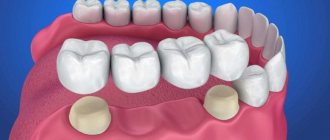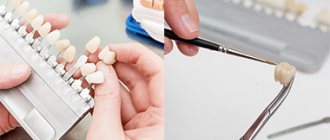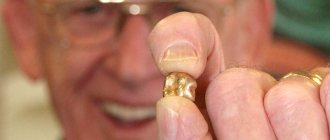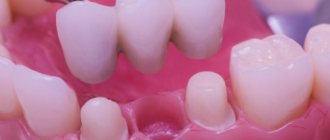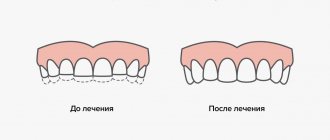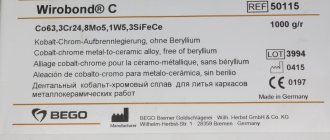Reasons for chipping ceramics in metal-ceramic structures
At the junction of the metal frame of the denture and the ceramic coating, strong stresses often arise, which in stressful situations lead to the formation of cracks, chips or spalls in the ceramics.
The main reasons for ceramic chipping are:
- Mismatch between the thermal expansion coefficients of ceramics and the metal alloy from which the frame is made.
- Unreasonable choice of metal ceramics as a material for a fixed prosthesis in some patients (for example, those suffering from bruxism).
- If the intermediate part of a metal-ceramic bridge is too long, the frame of which is made of precious alloys (which have lower rigidity than non-precious alloys), chewing loads on it can lead to chipping of the veneer.
- Incorrect tooth preparation, for example, insufficient taper, can lead to stress in the framework of the metal-ceramic crown and subsequent chipping of the veneer.
- Chips often occur when performing orthopedic work (especially large-scale ones) without an articulator and a facebow.
- When fixing a metal-ceramic prosthesis with excessively thick cement, or when foreign bodies get between the tooth stump and the crown.
- Chips may be a consequence of incorrect modeling of the metal-ceramic frame of the future prosthesis:
- insufficient height of the frame, which necessitates the layering of an excessive amount of ceramics - unmodeled tooth relief - non-compliance with the technology of mechanical and chemical processing of the metal frame - holes in the metal frame, which technicians close with ceramics. Subsequently, after cementing the crowns, tension arises here, since the cement presses evenly on all walls and later a chip forms in this place and rapid decementing of the structure.
If you have a problem similar to that described in this article, be sure to contact our specialists. Don't diagnose yourself!
Why you should call us now:
- We will answer all your questions in 3 minutes
- Free consultation
- The average work experience of doctors is 12 years
- Convenient location of clinics
Single contact phone number: +7
Make an appointment
- The cause of chipping may be stress in the ceramics or metal frame, resulting from non-compliance with technological rules for working with ceramics:
- overheating of the metal during firing of ceramics - violation of temperature relationships during successive firing and cooling of ceramics - violation of the rules for working with ceramic masses offered by manufacturers - non-compliance with ceramic processing technology.
- Careless or careless handling of the patient with prosthetic metal-ceramic structures. The fragility of ceramics under inadequate loads, and less often during sudden temperature changes, should be taken into account. We also recommend that you read the article about installing ceramic crowns at 32Dent dentistry.
What is a metal-ceramic crown?
Today, the choice of materials for making dental crowns is very wide: ceramics, zirconium dioxide, and plastic, but metal-ceramics continues to be the most popular and affordable. At the moment, metal ceramics are a kind of gold standard in dentistry, since similar designs have been used by doctors for many years and have proven themselves to be good.
Metal-ceramic crowns are a “cap” with machined fissures, which is placed on a ground tooth and completely imitates its shape, including all anatomical formations. The basis for the structure is a metal frame, which is covered on top with a layer of ceramics, indistinguishable in color from natural enamel. The prosthesis is secured to the ground dental tissues using special composite or glass ionomer cement. In case of severe destruction, a metal tab is first installed, which serves as a reliable basis for the crown. Metal-ceramics are also used for the manufacture of bridges and clasp dentures supported both on the patient’s own teeth and on dental implants. In the latter case, the use of implants with metal abutments is recommended.
Types of structures based on metal at the base
When answering the question of what metal the frame is made of, it should be noted that there are several options. The type of metal at the base of the structure directly affects its performance characteristics. Listed below are the compositions that are commonly used to create such products.
Alloy of noble metals (gold, platinum, palladium)
These materials do not provoke an allergic reaction, with only rare exceptions (about 1 in 100 people). Products based on alloys of noble materials last longer - about 15 years. In addition, gold, platinum and palladium react less with the oral environment and also allow for a natural appearance. A translucent ceramic mass applied to a base with the addition of gold will give the prosthesis a natural, slightly yellowish tint.
Base metal alloy (cobalt, nickel, chromium)
Such designs will cost less, but can provoke allergies. Over time, they lead to darkening of the mucosa in the area of contact with the metal frame. The nuance is that with the standard method of creating a prosthesis with a ledge, the base is lined on all sides, except for the area of \u200b\u200bthis ledge - where the edge goes slightly under the gum. Thus, the metal inevitably comes into contact with the mucous membrane and over time can give it a bluish color.
“I started having problems with my teeth after my second birth, then the front ones became very weak, darkened, and I started having problems with my gums. I even had to put a crown in place of one. The doctor recommended metal-ceramics, but the problem turned out to be that the tooth was noticeable when smiling. At first everything was fine, but only over time the gums above it darkened. It was only later that I learned that it is better to use zirconium or special metal-ceramics on the front ones...”
MariannaKleo, 32 years old, from correspondence on the woman.ru forum
Today in dentistry crowns with shoulder mass are widely used - when creating them, the ledge is also lined with ceramics, which avoids its contact with the gum. You just need to take into account that such products will cost 2-2.5 times more than standard models with a ledge.
Titanium base
The material is extremely durable and resistant to stress. Today, pure titanium and its alloys are widely used for the manufacture of implants - dental root substitutes. The material is completely compatible with the human body, it does not lose its shape over time, is almost never rejected and does not provoke allergic reactions. But, of course, it is quite expensive.
Pros and cons of a metal-ceramic crown
Among the advantages of metal-ceramic crowns is, first of all, their strength. Therefore, in most cases they are installed on chewing teeth. Undoubtedly, they look much better than purely metal crowns. In general, metal-ceramic crowns imitate real teeth well, but with the advent of new materials in prosthetics, preference in restoring anterior teeth began to be given to all-ceramic structures. When a combination of reliability and aesthetics is needed in the chewing area, then the best choice would be ceramic prostheses based on zirconium dioxide.
Make an appointment
right now!
Akhmedkhanov Said Rashidovich
Surgeon, Therapist, Orthopedist, Hygienist, Implantologist
General overview
The mechanical strength of the prosthesis, the ability to withstand loads, as well as the stability of a given position are characteristics determined by the design specifics and the quality of the materials used. Metal acrylic crowns repeat the features of the anatomical structure of the problem tooth, preserving the natural occlusal line and preventing further destruction. The structure, placed over the tooth, restores chewing function and eliminates the possibility of uneven pressure.
What are the differences between metal-ceramic crowns?
Indeed, many patients wonder: what is better - zirconium crowns or metal-ceramics? Roughly speaking, both structures are metal-ceramic, but zirconium is a “white” material that does not shine through the ceramic, as sometimes happens with ordinary metal. Therefore, today ceramic crowns on a zirconium frame are close in aesthetic qualities to all-ceramic crowns, but at the same time they have the same strength as metal-ceramics. However, prices for such prostheses are higher than for metal-ceramic structures without the use of zirconium.
The question of which is better - metal-ceramic or ceramic crowns cannot be answered unequivocally. The choice is made depending on the indications and budget. So, if prosthetics of the frontal group of teeth is necessary, it is recommended to choose solid ceramics. It is aesthetic metal ceramics. Typically, such crowns are placed on teeth where the chewing load is less, since the metal-ceramic frame is stronger. Regarding the issue of price, a metal-ceramic crown is, of course, cheaper.
Prosthetics with metal-ceramics
Advantages of metal-ceramic prosthetics
The following facts speak in favor of the use of metal ceramics:
- correspondence of artificial metal-ceramic teeth to natural ones in function and appearance
- the possibility of prosthetics for both frontal and lateral teeth, included and end defects of the dentition, the ability to combine removable and non-removable metal-ceramic structures.
- "hygienic" Microbial plaque settles less on metal-ceramic teeth than on natural teeth, which is especially important for patients with periodontitis.
- durability. Today, metal ceramics are one of the most durable structures used in dentistry. If a metal-ceramic crown is made using modern materials and techniques, then its service life is on average from 10 (on a non-precious alloy) to 15 (on a gold-platinum alloy) years.
- A properly made metal-ceramic crown will never cause unpleasant changes in the gums, such as bleeding, changes in color or contour.
Types of metal-ceramic crowns
Metal-ceramic crowns have several classifications: according to the frame material and according to the ceramic material. Thus, according to the frame material, crowns are distinguished based on a chromium-nickel alloy, based on a cobalt-chromium alloy, and based on a gold-platinum (palladium) alloy (based on the so-called “noble alloys”). There is also another material that is used quite rarely - titanium alloy. Each of these types of metal-ceramic crowns has its own pros and cons. Traditionally, the most popular material is cobalt-chromium alloy. Based on the ceramic material, a distinction is made between conventional (high-temperature) and low-temperature ceramics. Low-temperature ceramics based on “noble” alloys look more aesthetically pleasing.
Ranking of dental crowns by nomination
| The most | |
| Aesthetic | Unaesthetic |
| Zirconium | Metal |
| Durable | Short-lived |
| Zirconium/Metal | Metal-plastic |
| Biologically compatible | Unsafe for the body |
| Zirconium/Ceramic/Metal-ceramic with gold-platinum alloy frame | Nickel-based metal-ceramic |
Indications and contraindications for metal-ceramic crowns
The indications for installing a metal-ceramic crown are the same as for crowns made of other materials. The main one is the index of destruction of the coronal surface of the tooth, equal to 0.6. Also, indications for installing a metal-ceramic crown are:
- any non-carious lesions, for example, fluorosis or enamel hypoplasia;
- abnormal development and position of the front teeth in adults, which for any reason cannot be eliminated by orthodontic methods;
- pathological abrasion or wedge-shaped defect;
- aesthetic defect in the crowns of natural teeth (changes in color and shape, loss of shine, etc.);
- inconsistency of existing artificial crowns with aesthetic and functional requirements;
- metal-ceramic crowns can also be used as a splinting structure for mild to moderate periodontitis;
Each of the above indications should be considered in the context of a specific clinical case. Contraindications include, for example, bruxism, as well as periodontitis, accompanied by severe tooth mobility. In addition, fixed prosthetics on implants also involves the use of metal-ceramic crowns.
Is it possible to put metal-ceramic crowns on the front teeth?
It is possible if the patient’s budget does not allow for all-ceramic crowns. There are no medical contraindications to the manufacture of metal-ceramic crowns on the frontal teeth. However, aesthetics in this case recedes into the background. Such crowns will not look very natural. Therefore, it is still better not to place metal-ceramic crowns on the front teeth.
Contraindications
Metal-ceramic crowns are not used for prosthetics in the following situations or conditions:
- destroyed crown part of the tooth in children under 16 years of age;
- low or flat coronal part with a thin layer of enamel-dentin layer and proximity to the pulp chamber;
- advanced periodontal disease;
- deep crossbite;
- parafunction of masticatory muscles and bruxism;
- pathological mobility of teeth 3 degrees;
- chronic periapical inflammation.
Installing a metal-ceramic crown on a tooth
- The first stage of installing a metal-ceramic crown can be called clinical. The doctor treats the tooth and its canals, prepares dental tissue for the future crown and takes an impression.
- After this, the laboratory stage begins: in the laboratory, a crown frame is made, which we then try on, check its reliability and fit to the tooth, correct defects, if any, and also choose the color of the future structure. The frame is then taken back to the laboratory, where a technician applies ceramic paste to it.
- When the crown is ready, the doctor invites the patient to an appointment and installs it.
While the prosthesis is being manufactured, which can last from one to two weeks, a temporary crown is installed on the tooth.
Metal-ceramic crown with shoulder
There are no metal-ceramic crowns with a shoulder. The tooth is ground with a shoulder, and the metal-ceramic crown is made with a ceramic shoulder. That is, the edges of the metal frame of the crown are lined with a special “shoulder” ceramic mass. This is done to improve the aesthetics of prosthetics with metal-ceramic crowns, as well as to prevent “cyanosis” (translucency of the metal frame) in the crown-tooth transition zone.
Alternatives to a Dental Crown
Veneers are often preferred to crowns in the smile area. However, in this case, the back side of the elements should be more or less preserved.
Teeth can be restored using filling materials. This method can only be used if the destruction of the unit is not so global (less than half).
Judging by the reviews of doctors and patients, crowns are considered the optimal solution for significant damage to teeth, since they not only restore the functionality and aesthetics of a row, but also protect teeth from further destruction. An additional bonus of this type of prosthetics is the variability of materials and, accordingly, the cost of services.
Service life of metal-ceramic crowns
How long does a metal-ceramic crown last? Modern products last on average about 10 – 12 years. If a chip occurs on the metal-ceramic crown of the ceramic layer, then in some cases repair is possible. If it did not occur due to the development of secondary caries under the prosthesis, but as a result of mechanical damage, the dentist assesses the volume of the chip and, if the metal frame is not exposed, restoration of the metal-ceramic crown can be carried out using grinding or composite materials. If a serious chip occurs on the metal-ceramic crown, the prosthesis must be replaced.
Once the service life of the prosthesis has expired, the structure must be replaced. This is due to the fact that the special cement on which the structure is attached begins to deteriorate over time under the influence of saliva and other factors. If the crown is not removed in time, a problem may arise such as secondary caries, developing under the cap and at its junction with the tooth tissue.
Advantages
A metal frame coated with an acrylic layer provides reliable protection for damaged dental elements. Among the positive aspects noted by dentists and patients who have experience working with metal acrylic crowns are:
- Ease of manufacture and installation;
- Possibility of use for one-stage prosthetics;
- Affordable cost, comparable to budget models;
- Reliable fixation on the base;
- Optional repair that does not require radical intervention.
Alloys, like the polymer coating, are easy to mold, which allows you to recreate an exact imitation of the tooth. When preparing the prosthesis, individual parameters are taken into account, due to which the artificial element is tightly and hermetically located on the prepared base. The color properties of acrylic allow you to choose a shade that matches natural enamel and preserve the aesthetics of your smile.
Caring for metal-ceramic crowns
The rules for caring for metal-ceramic crowns are practically no different from the rules for caring for natural teeth. However, less interdental plaque and tartar are formed on the metal-ceramic surface than on natural enamel. For care, it is necessary to use dental floss, brushes and, preferably, an irrigator to avoid the accumulation of plaque at the transition boundary from the crown to the tooth. During the professional hygiene procedure, the structure must be polished. Otherwise, timely attendance at preventive examinations and thorough daily cleaning will help the metal-ceramic crown serve its full service life.
Is metal-ceramics suitable for restoration of the smile area?
It is preferable to place zirconium products or structures made from E.max ceramics on the front teeth. Both options are characterized by increased strength and high aesthetic characteristics. On the other hand, the cost of installing such products will be an order of magnitude higher, and if the patient does not have such financial capabilities, then preference can be given to metal ceramics. For the smile area, it is better to use products with shoulder mass, which do not expose the metal base over time and have less risk of causing discoloration of the adjacent gums.
How much do metal-ceramic crowns cost in Moscow?
The price of metal-ceramic crowns per tooth depends on the price category of the clinic in Moscow, the metal used to make the frame, the qualifications of the prosthetist and dental technician, the complexity of the clinical case and a number of other factors. The price of a metal-ceramic crown for one tooth starts from 7,000 rubles. However, it does not include additional costs. The total cost of a dental crown made of metal ceramics, including taking impressions, installing a temporary crown and fixing a permanent one, is about 10,000 rubles, which, in general, is very inexpensive in Moscow.
Publisher: Expert magazine about dentistry Startsmile.ru
Varieties of ceramic coating application
The prostheses under consideration come in different types, based on the characteristics of their external coating. These are the varieties that are distinguished today in dentistry:
- standard designs: metal frame with ceramic lining and a ledge at the bottom, which is not covered with anything. As a result, the metal inevitably comes into contact with the gum, and over time it may acquire a bluish tint,
- with shoulder mass: in this design there is no open shoulder, since it is also covered with ceramic mass. This makes the prosthesis more aesthetic when fixed in front (in the smile area). The thickness of the outer coating is greater, and the base is thinner. In this case, the frame does not have any contact with the marginal mucosa.
%akc72%
The last option can be safely used on the front teeth, as it gives a more aesthetic result in the long term. But you need to find out in advance how much it will cost to install a crown with a shoulder mass. The technology for its creation is more complex, which will inevitably affect the cost of restoration.
Work examples
All works
Restoring chewing function with metal-ceramic crowns
Re-prosthetics with metal-ceramic crowns
Manufacturing of metal-ceramic fixed bridge prosthesis
Tooth restoration with a metal-ceramic crown
All works
Sign up for a consultation
three ROOTT specialists + diagnostics as a gift
Conventional crowns or with shoulder mass
The best metal-ceramic dentures are considered to be those whose lower edge is also lined with ceramics, that is, over time, the metal will not begin to emerge from under the gums and will not spoil the aesthetics of the smile. Here's what exactly is good about ceramic-metal products with shoulder mass:
- the marginal gum does not acquire a bluish tint over time,
- products are stronger and more durable,
- high aesthetics, which is also due to the increased thickness of the ceramic layer,
- minimal risk of an allergic reaction due to the absence of direct contact of the metal base with the gum.
Obviously, this prosthetic option will cost the patient more, at least twice as much. Such designs are more complex to manufacture, which inevitably affects the final cost of treatment.
Installation process
Now let's talk about how cermets are installed.
- First of all, you need to undergo a diagnosis.
- Dental preparation procedure. Contrary to popular belief, installing metal ceramics on a living tooth is quite possible. However, in most cases there is a need to depulpate the tooth.
- After this, the orthopedic doctor will be able to take impressions of the ground teeth necessary for the manufacture of individual structures.
- Fixation of the prosthesis.
Many patients are interested in how teeth are ground for metal-plastic - dentures with a metal frame and a plastic coating on top. The preparation technique is the same as when installing metal-ceramic structures, but the tooth undergoes much more significant grinding due to the massiveness of the metal-plastic structures.
If you decide to install dentures, choose trusted dentists here.
Features of care
Article Expert
Popkov Sergey Yurievich Dentist-orthopedist, doctor of the highest category
Work experience: more than 14 years
